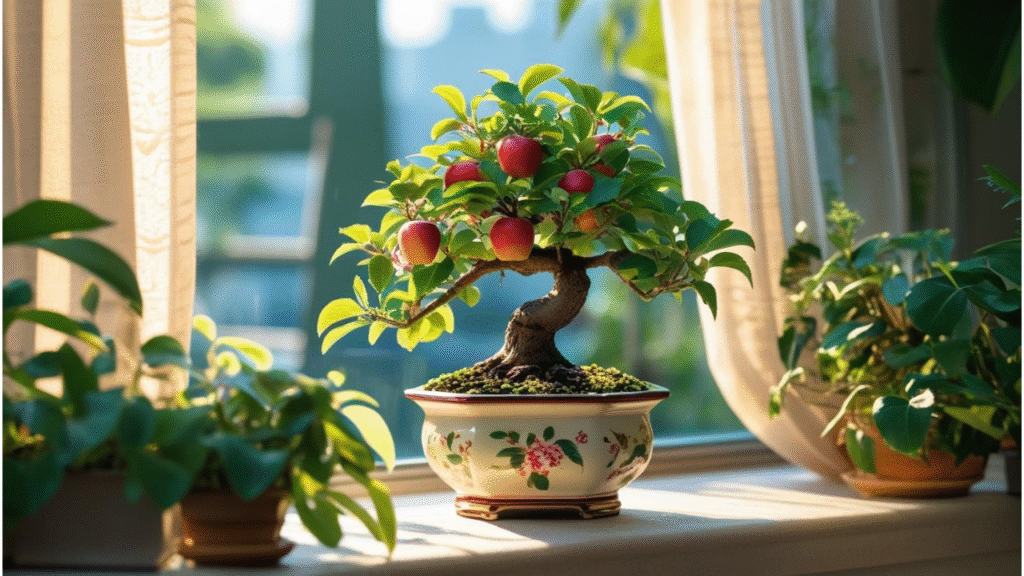
How to Grow a Bonsai Apple Tree: The Ultimate Guide to Perfecting Your Mini Orchard at Home
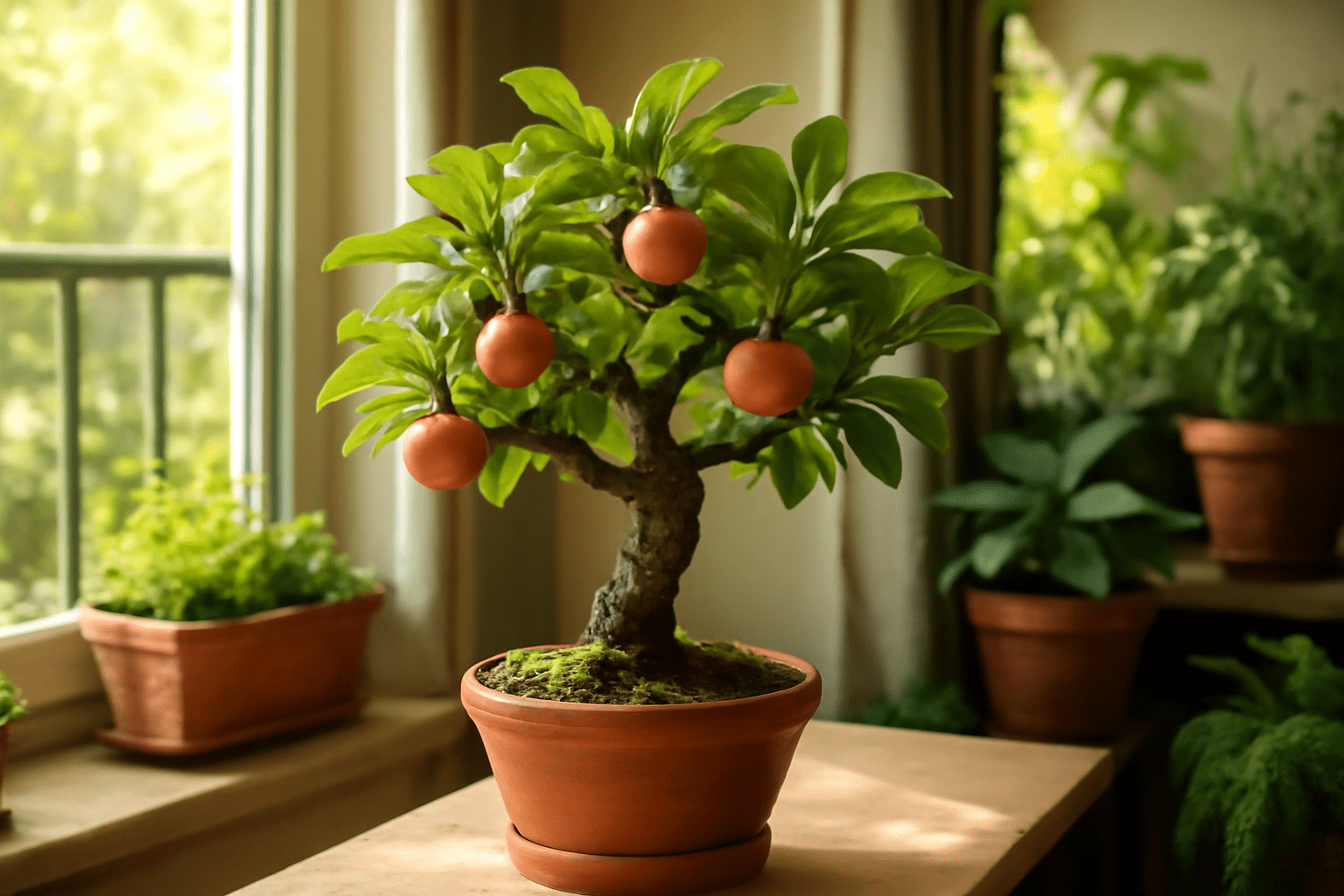
Table of Contents
Toggle🍏🌳 Choosing the Right Variety of Bonsai Apple Tree 🍏🌳
When it comes to growing a bonsai apple tree 🌳, choosing the right variety 🍏 is key to your success 🌱. With so many options available 🌿, it can be overwhelming to know where to start 🧐. Don’t worry—we’ve got you covered! Let’s break it down and make your decision easier 😊.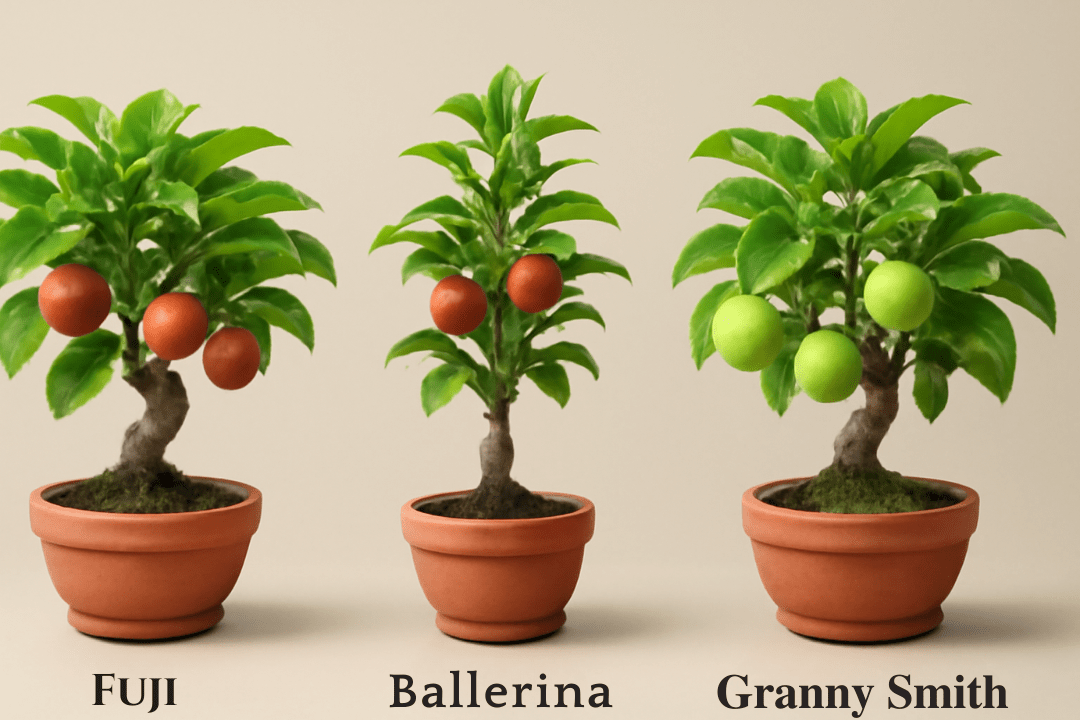
🍎 Best Varieties for Beginners: Miniature Apple Trees 🍏
The best bonsai apple trees 🌳 for beginners 👩🌾 are typically dwarf 🌱 or miniature varieties 🍏. These trees 🌳 are naturally compact 💚, making them perfect for growing in small spaces 🏡. Some popular beginner-friendly options include:- Miniature Fuji Apple 🍏: Known for its delicious 🍏, sweet apples 🍏, the Fuji variety 🍏 is easy to care for 🌿 and produces fruit 🍏 relatively quickly ⏳.
- Ballerina Apple 🍏: This variety 🌳 is especially compact 🏡, making it ideal for indoor spaces 🏠. It’s also self-pollinating 🌸, meaning you won’t need a second tree 🌳 for fruit production 🍏!
- Granny Smith 🍏: A hardy variety 🌱 with tart, green apples 🍏, perfect for those who love a tangy taste 🍏. It’s also a great choice 🌳 for beginners as it’s resistant to common pests 🐛 and diseases 🦠.
🌞 Climate Considerations: Pick a Tree That Thrives in Your Area 🌞
Not all bonsai apple trees 🌳 grow well in every climate 🌡️. Some varieties 🌳 need a cold winter ❄️ to bloom 🌸, while others are better suited for warmer conditions 🌞. Here’s what to consider 🧐:- Cold Climates ❄️: Varieties like Granny Smith 🍏 and Honeycrisp 🍏 thrive in cooler temperatures 🌨️, making them perfect for regions with harsh winters 🌬️.
- Warmer Climates 🌞: If you live in a warmer area 🏝️, go for Dwarf Fuji 🍏 or Ballerina Apple 🍏, which are more tolerant of heat 🔥 and don’t require a chilling period 🧊 to produce fruit 🍏.
📝 Size Matters: Don’t Forget the Space 📝
Even though you’re growing a bonsai apple tree 🌳, some varieties 🌱 still need enough room 🏡 to grow 🌿. If you’re growing your tree indoors 🏠, consider varieties 🌳 that are specifically bred to stay small 🪴. Dwarf varieties like Ballerina 🍏 or Miniature Fuji 🍏 won’t outgrow their pot 🪴, making them perfect for windowsills 🏡, balconies 🏠, or small gardens 🌱.🌳🍏 Time to Choose Your Perfect Bonsai Apple Tree 🍏✨
Choosing the right variety of bonsai apple tree 🍏 is essential to ensuring your mini orchard 🌳 thrives 🌱. Keep in mind your climate 🌞, available space 🏡, and the specific care requirements of each variety 🌳. By picking a variety 🍏 that fits your environment 🌍 and experience level 🧑🌾, you’ll be well on your way to growing a thriving 🍏, fruitful tree 🌳 right at home 🏡. Happy planting 🌱! 🌳😊🌿🍏 Preparing for Planting Your Bonsai Apple Tree 🍏🌿
Before you start planting 🌱 your bonsai apple tree 🌳, it’s essential to gather the right tools 🧰, choose the right pot 🪴 and soil 🌱, and time your planting for optimal growth 🌱. Follow these steps 📝 to ensure your tree 🌳 gets the best start possible 🌱. 😊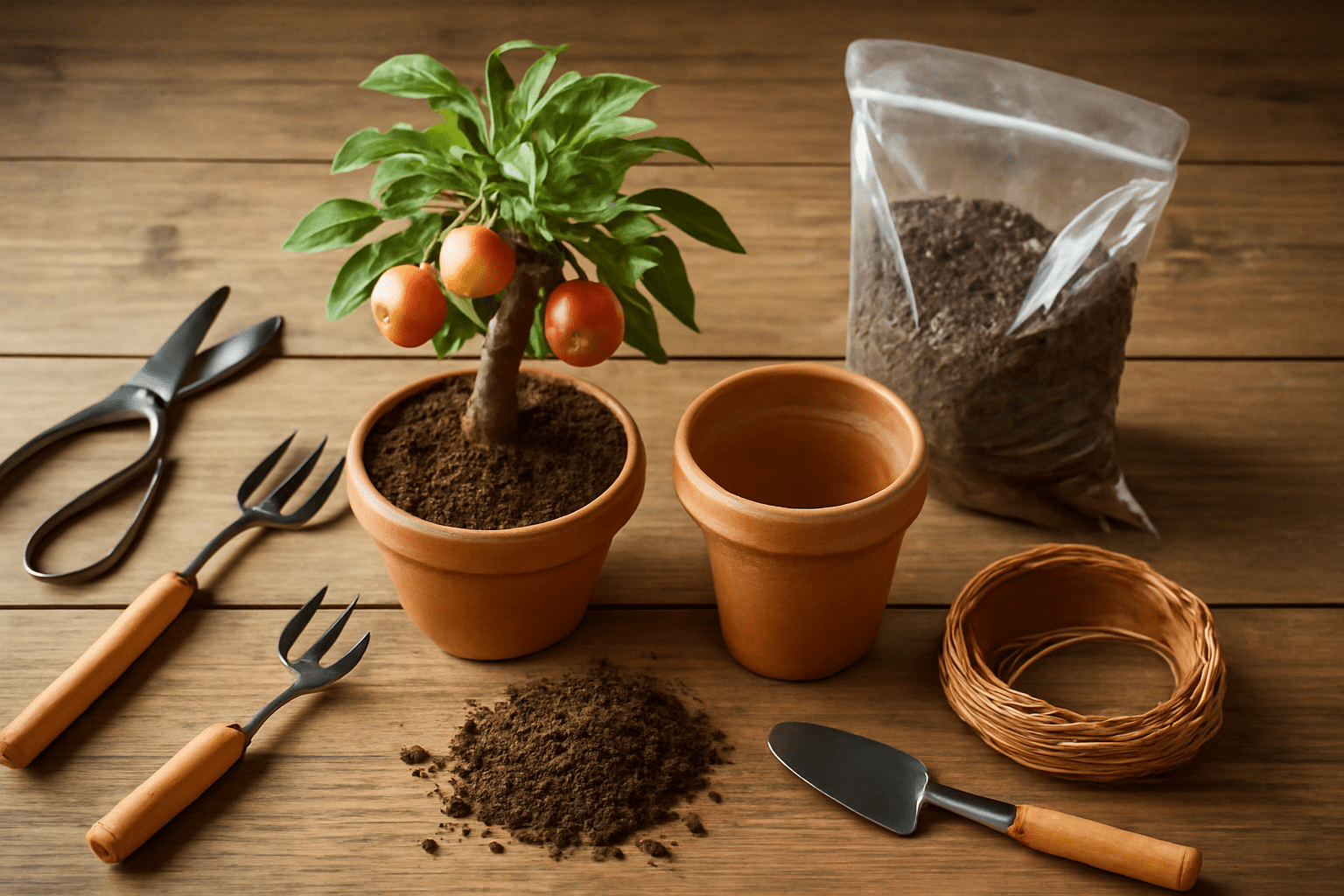
🍯 Choosing the Right Pot and Soil 🍯
The foundation of a healthy bonsai apple tree 🌳 begins with the right pot 🪴 and soil 🌱. Here’s how to get it right:- Pot with Drainage Holes 🍃: A pot 🪴 with a drainage hole 🔲 is absolutely crucial for preventing waterlogged soil 🌍, which can lead to root rot 🦠. Make sure the pot 🪴 is deep enough to allow the roots 🌱 to spread comfortably, especially in the early stages of growth 🌱. A good starting size for most bonsai apple trees 🌳 is about 12 inches in diameter 📏.
- Soil Mix 🌱: Bonsai trees 🌳, including apple trees 🍏, thrive in well-draining soil 🌍. The best soil mix for your tree 🌳 should include:
- Potting Soil 🌱: A base of good-quality potting soil 🌿 that provides the necessary nutrients 🧑🌾.
- Sand 🏖️: Helps with drainage 🌊, preventing the soil 🌍 from becoming too dense.
- Perlite 🪴: A lightweight material 🌿 that improves aeration and helps the roots 🌱 breathe.
🔧 Essential Tools and Materials 🔧
Having the right tools 🧰 will make the planting process easier 🌱 and ensure the long-term success 🏆 of your tree 🌳. Here are the essentials you’ll need:- Pruning Shears ✂️: These will be necessary for trimming ✂️ any dead or damaged branches 🍃 when you shape 🪴 your tree 🌳. Regular pruning ✂️ will also help your tree 🌳 grow in a compact, bonsai-style shape 🌱.
- Bonsai Wire 🎋: To help shape your tree 🌳, bonsai wire 🎋 is key. Gently wrap it around branches 🌿 to encourage them to grow in the desired direction 🏞️. This allows you to maintain the small, controlled shape 🌱 of your bonsai apple tree 🌳.
- Organic Fertilizers 🌿: Use organic fertilizers 🧴 to feed your tree 🌳 and support healthy growth 🌱. Choose a balanced fertilizer ⚖️ to give your bonsai apple tree 🍏 the nutrients it needs during its early growth stages 🌿. Feed your tree 🍏 every 4-6 weeks during the growing season 🌞 to keep it strong 💪 and vibrant 🌱.
🌸 Best Planting Time 🌸
Timing is everything ⏰ when it comes to planting 🌱 your bonsai apple tree 🌳. The ideal time ⏰ to plant is in early spring 🌱. At this time, the temperatures are mild 🌞, and the tree 🌳 will have the whole growing season 🌞 to establish roots 🌱 and start producing healthy new growth 🌱. Avoid planting 🌱 during the cold months ❄️ when the tree 🌳 is dormant 🛏️ or during extreme heat 🔥, as this can hinder its ability to root properly 🌱. By choosing the right pot 🪴, soil 🌱, tools 🧰, and timing ⏰, you’re setting your bonsai apple tree 🌳 up for success 🌱 from the start. With a little preparation 📝, you’ll be well on your way 🛤️ to growing a beautiful mini orchard 🌳 right at home 🏡! 🍏🌿🌿🍏 Step-by-Step Guide to Planting Your Bonsai Apple Tree 🌳🍏
Now that you’ve chosen the right pot 🪴, soil 🌱, and tools 🧰, it’s time to plant your bonsai apple tree 🌳. Follow this step-by-step guide 📝 to ensure your tree 🌳 gets a great start and thrives in its new home 🏡. 🌱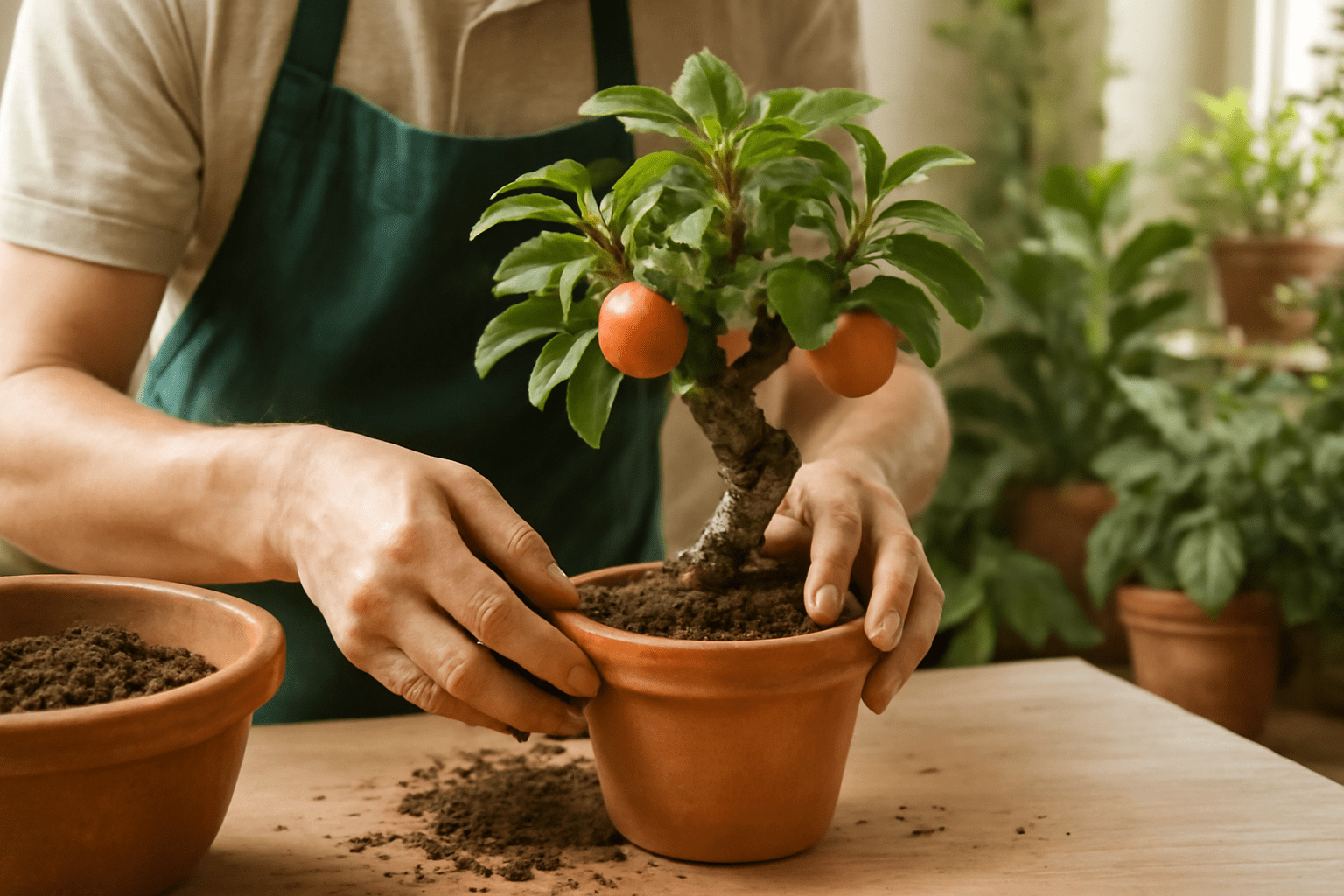
🍯 Preparing the Pot and Soil 🍯
Before planting 🌱, it’s essential to prepare both the pot 🪴 and the soil 🌱 for your tree 🌳’s roots to settle in comfortably.Choose the Right Pot 🪴
As mentioned, your pot 🪴 should have a drainage hole 🔲 to prevent water 🌊 from accumulating. This helps avoid root rot 🦠 and ensures good airflow around the roots 🌱. Start with a pot 🪴 that’s at least 12 inches in diameter 📏 for proper root development 🌿.Layer the Bottom 🌍
Begin by placing a layer of coarse gravel 🪨 or small rocks 🪶 at the bottom of the pot 🪴. This improves drainage 🌊 and keeps the soil 🌱 from clogging the drainage holes 🔲. About an inch or two of gravel 🪨 should be sufficient.Mix the Soil 🌱
Combine your potting soil 🌱, sand 🏖️, and perlite 🪴 to create a well-draining mixture 🧑🌾. Ensure the soil 🌍 is mixed evenly for optimal root health 🌱. A good ratio is 2 parts potting soil 🌱, 1 part sand 🏖️, and 1 part perlite 🪴.Add Soil to the Pot 🪴\
Once the gravel 🪨 is in place, fill the pot 🪴 with your prepared soil 🌱 mix, leaving about 2-3 inches of space 🏡 from the top of the pot 🪴. This gap will allow room for watering 🌊 without the soil 🌱 overflowing.Position the Tree 🌳
Before planting 🌱, make sure to check the bonsai apple tree 🍏’s root ball 🌱. Gently remove the tree 🌳 from its nursery pot 🪴 and shake off any excess soil 🌍. Position the root ball 🌱 in the center of the pot 🪴, ensuring it is level 📏. The top of the root ball 🌱 should sit about 1-2 inches below the rim of the pot 🪴 to allow for watering 🌊.🌱 Planting the Tree 🌱
Now it’s time to plant 🌱 your bonsai apple tree 🌳!- Place the Tree in the Center 🌳: Position the root ball 🌱 so it’s centered in the pot 🪴, with the roots 🌱 spread out gently. Be sure the tree 🌳’s trunk 🍏 is upright and stable 🏡. If necessary, add or remove soil 🌍 from the bottom to adjust the height of the root ball 🌱.
- Fill the Pot with Soil 🌱: Once the tree 🌳 is properly positioned 📏, fill in the surrounding space 🏡 with the remaining soil 🌱 mixture. Make sure to pack the soil 🌱 lightly around the roots 🌱 to eliminate air pockets 🫁. However, don’t press it too firmly 💪—roots 🌱 need room to grow and expand 🌱.
- Water Thoroughly 💧: After planting 🌱, give your bonsai apple tree 🌳 a good watering 💧. Water 🌊 it slowly and evenly 🌍, allowing the soil 🌱 to settle and ensuring that the entire root ball 🌱 is moistened 💦. Drainage 🔲 is key, so ensure the water 🌊 flows out of the pot 🪴’s drainage holes 🔲.
- Position the Tree 🌳: Once the tree 🌳 is planted and watered 💧, place it in a location 🏡 where it will get enough sunlight 🌞. Ideally, this is a spot 🏡 that gets 6 hours of direct sunlight 🌞 daily, especially during the growing season 🌱. Avoid placing it in an area that gets too much wind 🌬️ or where temperatures fluctuate dramatically 🌡️.
🌿🍏 Caring for Your Bonsai Apple Tree 🍏🌿
Proper care 🌱 is essential for keeping your bonsai apple tree 🌳 healthy and productive 🍏. With the right attention, you can maximize fruit 🍏 yield and ensure your tree 🌳 thrives for years to come. Here are some essential care tips 🌱 that will help you achieve just that.
💧 Watering Your Bonsai Apple Tree 💧
Watering 💦 is one of the most important aspects of bonsai care 🌱. Here’s how to get it just right:- When to Water 💧: Water 🌱 your bonsai apple tree 🌳 when the top 1-2 inches of soil 🌍 feels dry. Stick your finger 🖐️ into the soil 🌍, and if it feels dry to the touch, it’s time to water 💦. If the soil 🌍 is still damp 💧, wait a few days before checking again.
- How to Water 🌊: Always water 💦 deeply and thoroughly 🌍 to ensure the entire root system 🌱 gets hydrated. Water 🌊 slowly so the soil 🌍 absorbs it evenly. Be sure to let the water 💧 drain out through the bottom of the pot 🪴—this prevents the roots 🌱 from sitting in excess moisture 🌊, which can lead to root rot 🦠.
- Avoiding Overwatering 🚫: Overwatering 🌊 is a common mistake that can harm your bonsai apple tree 🌳. The key signs of overwatering 🌊 include yellowing leaves 🍃, soft or mushy roots 🌱, and a musty smell 👃 from the soil 🌍. Always ensure that your pot 🪴 has drainage holes 🔲 to allow excess water 🌊 to escape. If you notice these symptoms 😔, reduce watering 💧 and ensure the soil 🌍 has time to dry out between waterings 🌞.
🌿 Fertilizing Your Tree 🌿
Fertilizing 🌱 helps your bonsai apple tree 🌳 grow strong 💪 and produce healthy fruit 🍏. Here’s how to keep it nourished:- Organic or Slow-Release Fertilizers 🌿: Use organic 🌱 or slow-release fertilizers 🧴 to feed your tree 🌳. These types of fertilizers 🌱 provide a steady stream of nutrients 🧑🌾 over time, promoting healthy growth 🌿 without overwhelming the roots 🌱. Look for fertilizers 🌿 specifically designed for fruit trees 🍏 or bonsai.
- Feeding Schedule 📅:
- Spring and Summer 🌞: During the growing season 🌱, fertilize your tree 🌳 once a month 🗓️ to support its active growth 🌿. This helps the tree 🌳 develop strong roots 🌱, leaves 🍃, and fruit 🍏.
- Fall 🍂: Reduce feeding 🧑🌾 to every two months in the fall 🍂 as the tree 🌳 enters a dormant period 🛏️. Overfeeding during this time 🕰️ can cause stress 😞 and damage to the tree 🌳.
- Tip 💡: Always follow the instructions on your fertilizer 🧴 packaging to avoid overfeeding 🍏, which can lead to nutrient imbalances ⚖️.
✂️ Pruning and Shaping for Maximum Growth ✂️
Regular pruning ✂️ is essential for keeping your bonsai apple tree 🌳 compact and healthy 🌱 while also encouraging fruit production 🍏. Follow these tips for effective pruning ✂️:- Pruning for Size and Shape 🌱: Trim back any dead or damaged branches 🍂 regularly. This helps your tree 🌳 focus its energy on healthy growth 🌿. You should also prune the branches 🌿 to maintain a compact shape 🍏 and prevent overcrowding 🏡. Aim to remove any crossing branches 🌿, as these can hinder airflow 🌬️ and light penetration 🌞.
- Shaping with Bonsai Wire 🎋: Use bonsai wire 🎋 to shape your tree 🌳. Gently wrap the wire 🎋 around the branches 🌿 and bend them into the desired position 🏡. Be sure to monitor the tree 🌳, as the wire 🎋 should not cut into the bark 🌳 or restrict growth 🌱.
- When to Prune ✂️: Pruning ✂️ should be done during the growing season 🌞 (spring and summer) 🌱 when the tree 🌳 is actively growing. Avoid heavy pruning ✂️ in fall 🍂 or winter ❄️, as this can stress the tree 🌳 during its dormancy period 🛏️.
🐞 Dealing with Pests and Diseases 🐞
Pests 🐛 and diseases 🦠 can threaten the health 🌱 of your bonsai apple tree 🌳, but with vigilance 👀, you can keep them at bay 🚫:Common Pests 🐛
Aphids 🦠, spider mites 🕷️, and scale insects 🦗 are common pests 🐛 that can harm your bonsai apple tree 🌳. These pests 🐛 can damage leaves 🍃, cause wilting 🌱, or even spread disease 🦠. Keep an eye 👀 out for tiny pests 🐜 on the undersides of leaves 🍃 or sticky residue 💧 on the plant 🌱.How to Prevent Pests 🐜
Regularly inspect 👀 your tree 🌳 for signs of pests 🐛, especially during the growing season 🌞. If you notice pests 🐛, gently rinse the tree 🌳 with water 🌊 or use a soft cloth 🧴 to wipe down the leaves 🍃. For more persistent infestations 🐜, consider using an organic pesticide 🌱 like neem oil 🧴.Organic Treatment for Diseases 🌱
Fungal 🦠 and bacterial diseases 🦠 can sometimes affect your tree 🌳, especially in humid 💧 or wet conditions 🌧️. To prevent diseases 🦠, avoid overwatering 💦 and ensure good air circulation 🌬️ around the tree 🌳. If you notice yellowing 🍃 or spotting on the leaves 🍏, apply an organic fungicide 🌱 or remove the affected leaves 🍃 to stop the spread of infection 🦠. Tip 💡: Preventing pest 🐛 problems is always easier than treating 🧴 them. Keep your tree 🌳 healthy 🌱 by maintaining proper watering 💦, pruning ✂️, and pest inspection practices 🧐. By following these steps 🌱 for watering 💦, feeding 🧴, pruning ✂️, and pest management 🦠, your bonsai apple tree 🌳 will thrive 🌱 and reward you with beautiful growth 🌳 and delicious fruit 🍏. Regular care 🧑🌾 will ensure that your tree 🌳 stays healthy 🌱 and produces high-quality apples 🍏 year after year. 🌳🍏🌿🍏 How to Encourage Fruit Growth on Your Bonsai Apple Tree 🍏🌳
One of the most exciting aspects of growing a bonsai apple tree 🌳 is watching it bloom 🌸 and eventually bear fruit 🍏. However, to get the best harvest, it’s essential to understand the pollination process and the fruiting cycle 🌱. In this section, we’ll cover the steps to encourage fruit growth 🍏 and ensure your mini orchard yields delicious apples! 🌿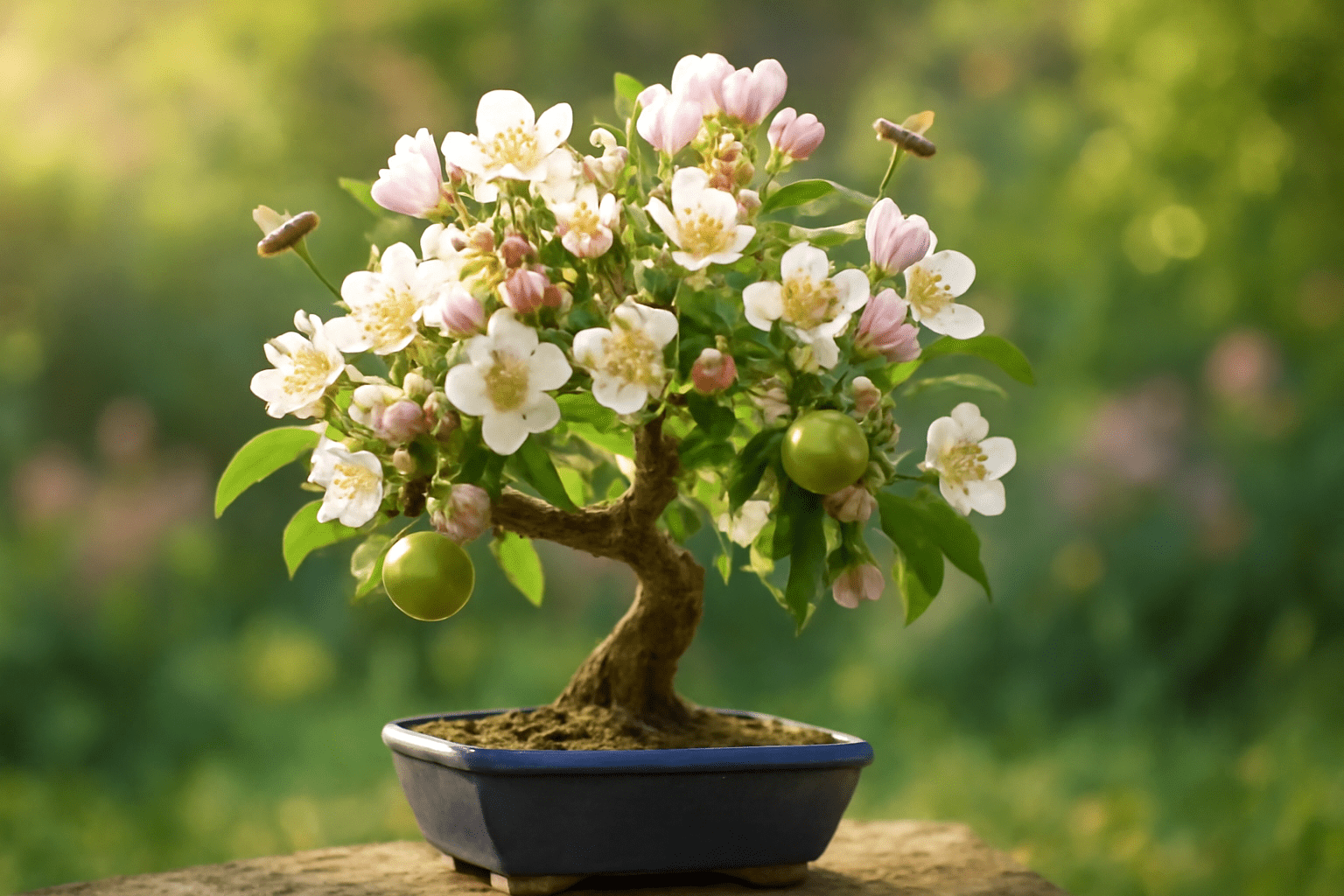
🌸 Pollination: Getting the Best Harvest 🌸
Pollination 🐝 is crucial for fruit production 🍏. Apple trees, including bonsai apple trees, rely on pollinators 🐝 (such as bees 🐝) or cross-pollination from another tree 🌳 to produce fruit 🍏.- Hand Pollination 🖌️: If you’re growing your bonsai apple tree 🌳 indoors 🏡 or in an area with fewer natural pollinators 🐝, you may need to help with the pollination process. To hand-pollinate, use a soft paintbrush 🖌️ or cotton swab to transfer pollen from the flowers 🌸 of one tree 🌳 to another. Gently brush the pollen from the stamen (the male part of the flower 🌸) and dab it onto the pistil (the female part) of a different flower 🌷. Repeat this for several flowers 🌸 on different trees 🌳 to maximize the chances of successful pollination. 🍯
- Cross-Pollination 🌳: Although some bonsai apple trees 🌳 are self-pollinating, most will benefit from cross-pollination 🌸. This means you’ll need at least two different apple varieties 🍏 planted nearby to increase the chances of a bountiful harvest 🍏. Varieties such as Miniature Fuji 🍏 and Ballerina Apple 🍏 are great choices for cross-pollination 🌳 because they flower at the same time 🌸, allowing for the efficient transfer of pollen 🐝 between the two trees 🌳.
🌱 Understanding the Fruiting Cycle 🌱
Knowing when to expect fruit 🍏 and understanding the timeline 🕰️ will help you manage your expectations and care for your bonsai apple tree 🌳 more effectively 🌱.When to Expect the First Fruits 🍏
For most bonsai apple trees 🌳, you can expect the first flowers 🌸 to bloom in the spring 🌞, usually around the second or third year after planting 🌱. The flowers 🌸 will eventually turn into small fruits 🍏 that will grow and ripen over time 🕰️. You may not get a large harvest 🍏 in the first couple of years, but with time ⏳ and care 🌱, your tree 🌳 will become more productive 🍏. 🌷How Long It Takes for Fruit to Mature ⏳
Once your bonsai apple tree 🌳 has set fruit 🍏, it can take anywhere from 3 to 6 months 🗓️ for the apples 🍏 to mature, depending on the variety 🍏 and growing conditions 🌞. The exact time ⏳ will also vary based on the climate 🌦️ in which you live. During this period, make sure your tree 🌳 receives enough sunlight 🌞, water 💧, and nutrients 🧑🌾 to support fruit 🍏 development. Keep an eye 👀 on the apples 🍏 as they grow—they will gradually change color 🎨 and size 📏, signaling that they’re approaching ripeness 🍏. 🌞When to Harvest 🍏
The best time to harvest 🍏 your bonsai apple tree 🌳 is when the apples 🍏 are fully ripe, typically when they have reached their full color 🎨 and are slightly soft to the touch ✋. Gently twist or cut the apples 🍏 from the branches 🌳, being careful not to damage the tree 🌳. Ripe apples 🍏 will come off with ease, and you’ll know they’re ready when their skin is vibrant 🌈 and the flesh feels firm ✨. 🍏 Tip 💡: Harvest your apples 🍏 in the morning 🌅 when they’re cool for the best flavor 🍏 and texture. Store them in a cool, dry place 🌬️, or refrigerate them 🧊 if you plan to keep them for longer. Encouraging fruit growth 🍏 on your bonsai apple tree 🌳 requires a little patience ⏳ and attention to detail 🌱, but with the right care 🌿, you’ll be rewarded with a bountiful harvest 🍏. By ensuring proper pollination 🐝 and understanding the fruiting cycle 🌱, your tree 🌳 will produce delicious apples 🍏 you can enjoy season after season 🌳. Happy gardening! 🌳🍏🌿🍏 Troubleshooting Common Issues with Bonsai Apple Trees 🍏🌿
Like any plant 🌱, your bonsai apple tree 🌳 may experience a few challenges along the way. Don’t worry! Many of these issues can be easily managed with the right knowledge and care 🌱. In this section, we’ll cover some common problems you might encounter with your tree 🌳 and offer practical solutions to keep it healthy 🌿 and thriving. 🌱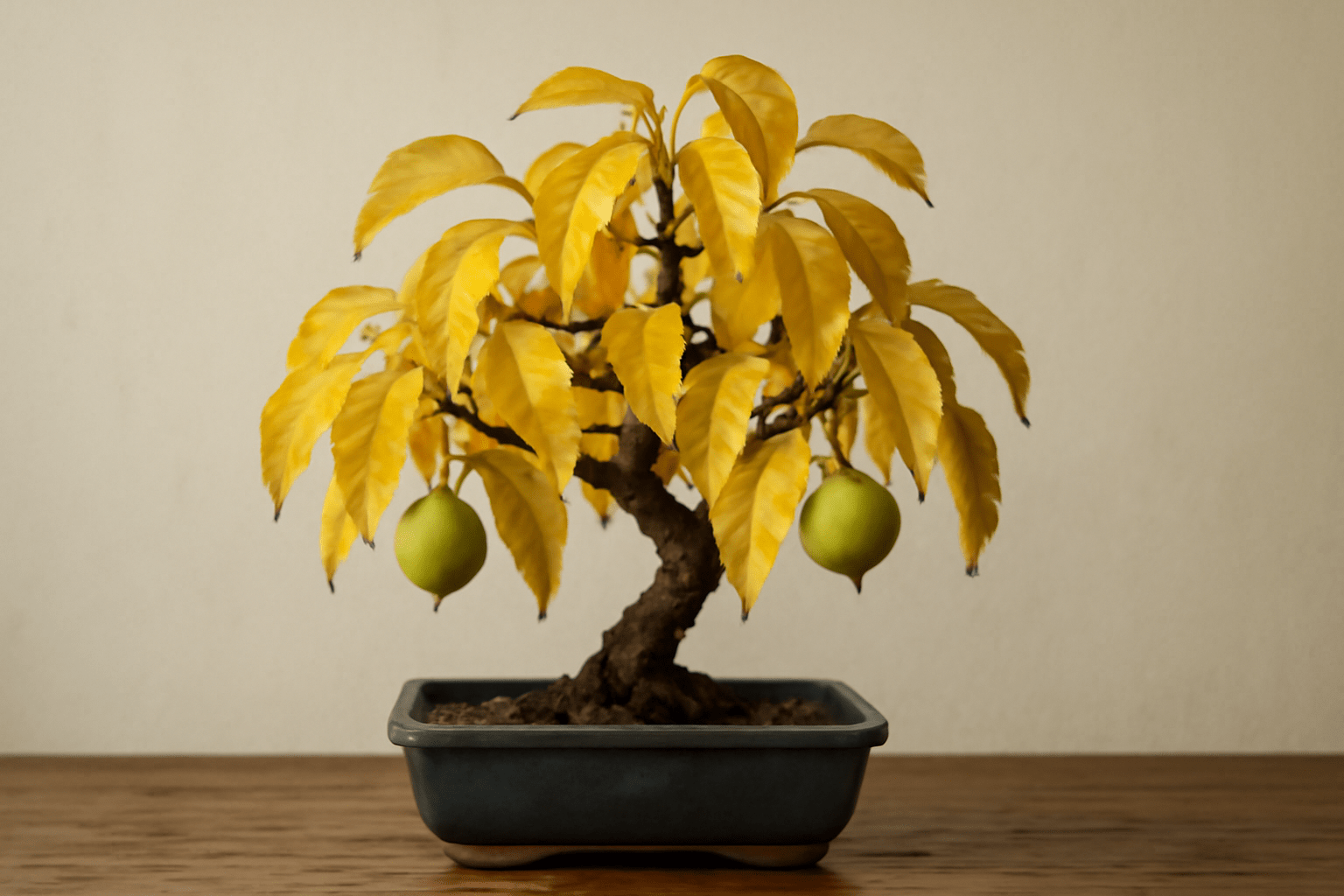
🍂 Yellowing Leaves or Poor Growth 🍂
Yellowing leaves 🍏 and poor growth 🌱 are common issues that can stem from a variety of causes. Here’s how to address them:- Overwatering 💦: One of the most frequent causes of yellowing leaves 🍏 is overwatering 💧. When the soil remains too wet, the roots can suffocate, leading to poor growth 🌱 and yellowing 🍏.
- Nutrient Deficiencies 🧑🌾: A lack of essential nutrients, especially nitrogen 🪴, can cause leaves 🍏 to turn yellow 🌿 and stunt growth 🌱.
- Insufficient Sunlight 🌞: Bonsai apple trees 🌳 require at least 6 hours of direct sunlight 🌞 each day. Without enough sunlight 🌞, the leaves 🍏 may turn yellow 🌿, and the tree 🌳 may struggle to thrive.
🍃 Leaf Drop or Wilt 🍃
Leaf drop 🍂 or wilting 🌿 can happen for a variety of reasons, from stress 🌡️ to pests 🐞. Here’s what to look for and how to fix it:- Stress 😫: Changes in environment 🏡, such as moving your tree 🌳 from indoors to outdoors 🌳 or vice versa, can cause stress and lead to leaf drop 🍂.
- Pests 🐞: Pests like aphids, spider mites 🕷️, and scale insects 🐜 can cause wilting 🌱 or leaf drop 🍂 by feeding on the leaves 🍏 and sap. They may leave behind sticky residue or visible insects on the undersides of leaves 🍃.
- Improper Care 🚫: Incorrect watering 💧 or not maintaining the right balance of sunlight 🌞 can lead to wilting 🌿. Ensure the tree 🌳 is getting the proper care 🌱 it needs, such as the right amount of water 💧 and sunlight 🌞.
❄️ How to Manage Winter Care ❄️
Winter can be a challenging season for your bonsai apple tree 🌳, especially if you live in a region with cold temperatures ❄️. Here’s how to manage winter care 🌱: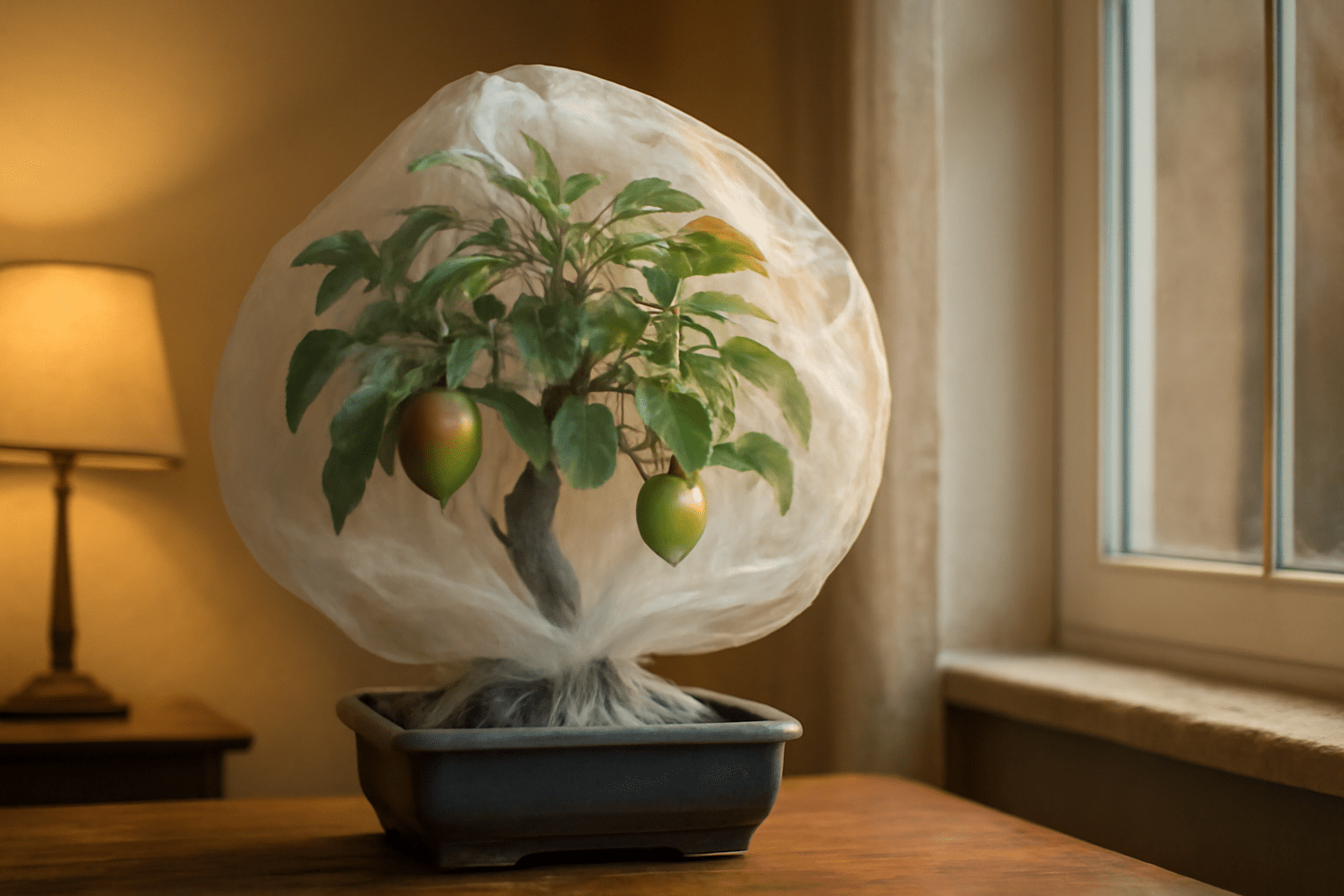
Protecting from Frost Damage ❄️
Frost can severely damage the delicate branches 🌿 and buds 🍏 of your bonsai apple tree 🌳. If the temperature drops too low 🌡️, the tree 🌳 may suffer irreparable damage. Solution 🔧: During the winter months ❄️, move your tree 🌳 indoors 🏡 to a cool but well-lit location 🌞, such as near a window with indirect sunlight 🌞. If the tree 🌳 must stay outside 🌳, use a frost cloth or burlap to protect the tree 🌳 from cold winds 🌬️ and freezing temperatures. ❄️Bringing Your Tree Indoors 🏡
If you’re growing your tree 🌳 indoors 🏡, keep it in a location where temperatures stay between 35°F and 50°F (1°C to 10°C) during the winter months 🌨️. It’s important not to place the tree 🌳 near heating vents 🔥, as dry air can harm the tree 🌳. Solution 🔧: Place your bonsai apple tree 🌳 near a window 🌞 that gets indirect light 🌞 but avoids extreme cold ❄️ or drafts 🌬️. Reduce watering 💧 during the winter to avoid overwatering, as the tree’s growth will slow down 🌱. 🌿 Tip 💡: During winter dormancy 🧳, the tree 🌳 won’t need as much care 🌱, but continue to check for pests 🐞, dry soil 🌿, or damaged branches 🌳. This period of rest 🌙 is vital for your tree’s overall health 🌿 and will help it prepare for the growing season ahead 🌱. 🌨️ By understanding and addressing these common issues 🌱, you can ensure your bonsai apple tree 🌳 remains healthy 🌿, beautiful 🌳, and productive 🍏. With the right care 🌱, your tree 🌳 will thrive and reward you with fresh 🍏, homegrown apples for years to come! 🍏🌳🌿🍏 Harvesting and Enjoying Your Bonsai Apple Tree’s Fruit 🍏🌳
After all your hard work and care 🌿, the moment you’ve been waiting for has finally arrived: it’s time to harvest your bonsai apple tree’s fruit! Harvesting your apples at the right time and enjoying the fruits of your labor is a truly rewarding experience. Let’s dive into the best practices for harvesting and making the most of your homegrown apples. 🌿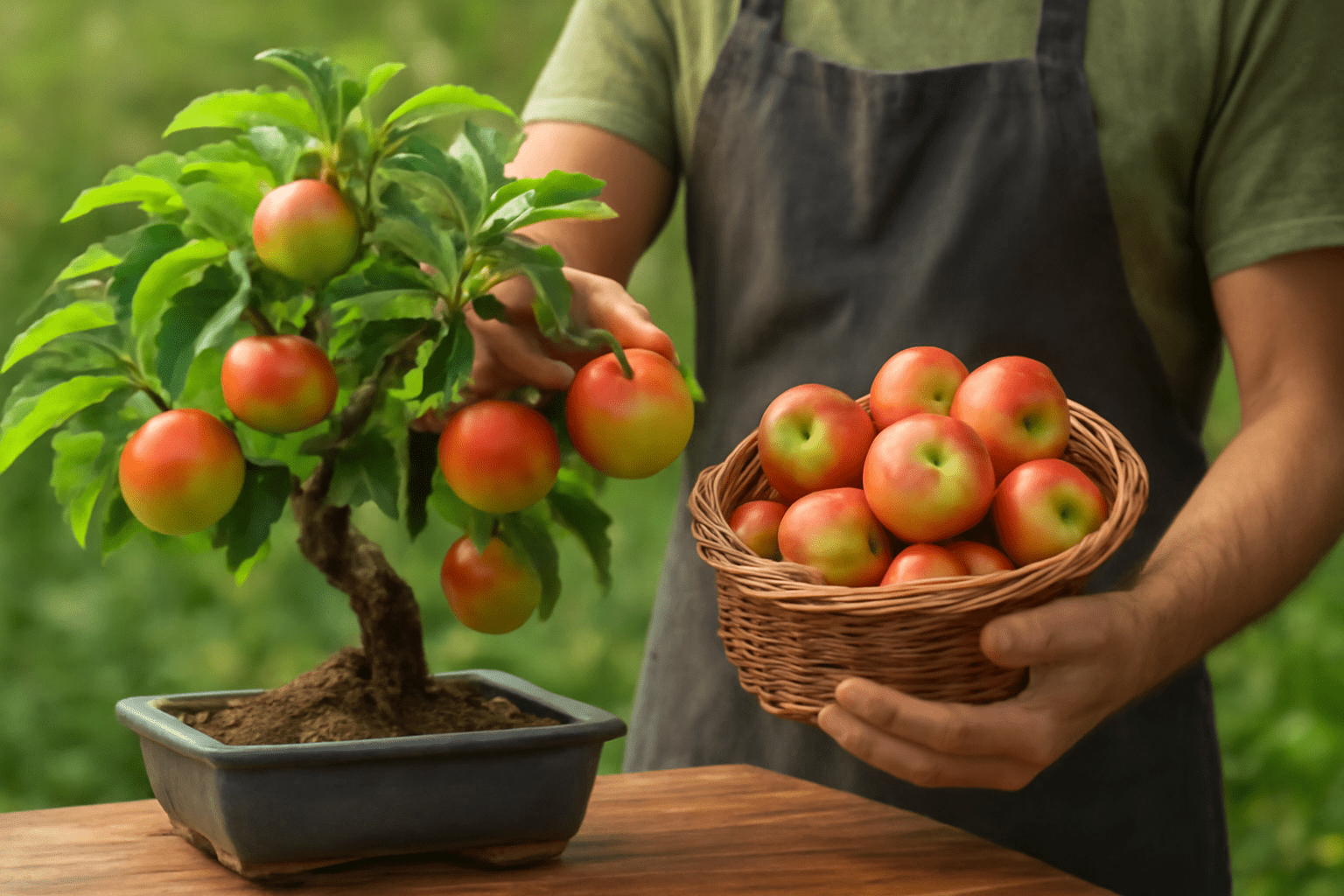
🍎 When to Harvest Your Apples 🍎
Knowing when to harvest your apples is key to ensuring they’re at their peak flavor and texture 🍏. Here’s how to tell when they’re ready to be picked:- Signs of Ripeness 🍏: Apples are ready to harvest when they’ve reached their full color and size 🌱. Different varieties will have different colors when ripe, so pay attention to the expected color of the variety you’re growing 🍎. For example, Granny Smith apples will be a vibrant green when ripe, while Fuji apples will turn a deep red.
- Test the Firmness 🌿: Gently squeeze an apple 🍏. If it feels firm and doesn’t give much when pressed, it’s likely ready to pick. Overripe apples 🍎 will feel soft and may have blemishes.
- Easy Removal 🍏: When ripe, apples 🍎 will come off the tree 🌳 easily with a gentle twist or tug. If you need to pull hard, the apple may not be fully ripe yet 🍏. Always handle the fruit 🍎 carefully to avoid bruising.
🍽️ Enjoying Your Homegrown Apples 🍽️
Once you’ve harvested your apples 🍏, the fun doesn’t end there! There are so many creative and delicious ways to enjoy your homegrown fruit 🍎:- Fresh Snacks 🍏: Enjoy your apples 🍏 fresh off the tree 🌳 as a healthy and satisfying snack 🥗. Slice them up and add a sprinkle of cinnamon for a delicious treat 🍏.
- Baking 🥧: Use your apples 🍏 to make delicious homemade pies 🥧, crumbles 🍏, or apple tarts 🍏. There’s nothing quite like the taste of a warm, freshly baked apple pie 🥧 made with your very own homegrown apples 🍏!
- Salads 🥗: Add a sweet and crunchy twist to salads 🥗 by tossing in slices of your apples 🍏. Pair them with walnuts 🌰, feta cheese 🧀, and a light vinaigrette for a refreshing dish 🥗.
- Cider or Juice 🍏: If you have a larger harvest 🍏, try making your own fresh apple cider 🍏 or juice 🍏. It’s a fun and rewarding way to use up extra apples 🍎 and enjoy a refreshing drink 🥤.
The Joy of Growing Your Own Fruit 🌱🍏
There’s nothing quite like the pride you feel when you harvest and enjoy the fruit 🍏 you’ve grown yourself 🌱. Whether you’re sharing your apples 🍏 with friends and family 👨👩👧👦 or savoring them on your own 🥰, each bite is a celebration of your gardening success 🎉. Plus, growing your own fruit 🌳 is not only environmentally friendly 🌍 but also incredibly rewarding! 🌱🍏 By harvesting at the right time ⏰ and getting creative with your recipes 🍽️, you’ll make the most of your bonsai apple tree’s fruit 🍏. Enjoy the sweet rewards 🍎 of your hard work 🌿, and celebrate your success as a gardener 🌱! 🎉🍏🌳🍏 Final Thoughts 🌳🍏
Growing a bonsai apple tree 🌱🍏 is not only a delightful gardening project but also a rewarding experience that brings you closer to nature 🌍. From carefully selecting the right variety 🍏 to nurturing it through the seasons 🌿, each step is an opportunity to learn and grow 🌱. With the right care—whether it’s proper watering 💧, feeding 🌾, pruning ✂️, or managing pests 🐞—you can ensure your tree thrives and bears delicious fruit 🍏.
Frequently Asked Questions (FAQs)
How long does it take for a bonsai apple tree to bear fruit?
It typically takes 2-4 years for a bonsai apple tree to produce fruit, depending on the variety and growing conditions. Be patient—young trees need time to establish roots and grow strong enough to support fruit production.
Can I grow a bonsai apple tree indoors?
Yes! Bonsai apple trees can thrive indoors as long as they receive at least 6 hours of direct sunlight daily. Place your tree near a bright window and maintain a consistent indoor temperature to help it grow.
What size pot is needed for a bonsai apple tree?
Start with a pot that is about 12 inches in diameter to allow room for root growth. Make sure the pot has drainage holes to prevent overwatering and root rot. As the tree grows, you can repot it into a slightly larger container.
Do bonsai apple trees need another tree for pollination?
While some bonsai apple trees are self-pollinating, most varieties will benefit from cross-pollination. Planting two different apple trees nearby helps increase fruit yield and ensures better pollination.
How do I know when my bonsai apple tree is ready to harvest?
Your apples are ready for harvest when they’ve reached their full color, are firm to the touch, and come off the tree easily with a gentle twist. The apples should be slightly soft but still firm, indicating they’re ripe for picking.
How often should I water my bonsai apple tree?
Water your bonsai apple tree when the top 1-2 inches of soil feel dry. Be careful not to overwater—ensure the pot has proper drainage to prevent the roots from sitting in excess water, which can lead to root rot.
How do I prune my bonsai apple tree?
Prune your tree regularly to maintain its compact size and shape. Trim away any dead or damaged branches, and remove any crossing branches to improve air circulation. Use bonsai wire to shape the branches and encourage a balanced, aesthetically pleasing form.
What should I do if my bonsai apple tree’s leaves turn yellow?
Yellowing leaves may indicate overwatering, nutrient deficiencies, or insufficient sunlight. Make sure the tree isn’t overwatered, ensure it’s in a sunny spot, and fertilize regularly to provide necessary nutrients.
